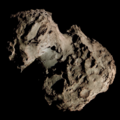455P/PanSTARRS
Appearance
(Redirected from 455P/PANSTARRS)
| Discovery | |
|---|---|
| Discovered by | Pan-STARRS |
| Discovery site | Haleakala Observatory |
| Discovery date | 30 September 2017 |
| Designations | |
| |
| P10E2ep | |
| Orbital characteristics[1][2] | |
| Epoch | 25 February 2023 (JD 2460000.5) |
| Observation arc | 11.03 years |
| Earliest precovery date | 21 August 2011 |
| Number of observations | 71 |
| Aphelion | 4.119 AU |
| Perihelion | 2.192 AU |
| Semi-major axis | 3.155 AU |
| Orbital period | 5.604 years |
| Inclination | 14.138° |
| 146.21° | |
| Argument of periapsis | 237.57° |
| Mean anomaly | 359.92° |
| Last perihelion | 25 February 2023 |
| Next perihelion | 1 October 2028 |
| TJupiter | 3.088 |
| Earth MOID | 1.234 AU |
| Jupiter MOID | 1.556 AU |
| Physical characteristics[3] | |
Mean radius | 0.5±0.2 km |
| Comet total magnitude (M1) | 9.4 |
455P/PANSTARRS is an Encke-type periodic comet that completes a 5.6-year orbit around the Sun within the main asteroid belt. It is also considered an active asteroid, whose orbit suggested it may belong to the Theobalda collisional family.[4]
References
[edit]- ^ "455P/PANSTARRS – JPL Small-Body Database Lookup". ssd.jpl.nasa.gov. Jet Propulsion Laboratory. Retrieved 20 May 2025.
- ^ "455P/PANSTARRS Orbit". Minor Planet Center. Retrieved 20 May 2025.
- ^ H. H. Hsieh; M. Micheli; M. S. P. Kelley; M. M. Knight; N. A. Moskovitz; et al. (2023). "Observational Characterization of Main-belt Comet and Candidate Main-belt Comet Nuclei". The Planetary Science Journal. 4 (3). arXiv:2302.11689. Bibcode:2023PSJ.....4...43H. doi:10.3847/PSJ/acbdfe.
- ^ Y. Xin; J. Shi; Y. Ma (2024). "Research of the family associations of active asteroids in the main belt". Monthly Notices of the Royal Astronomical Society. 527 (4): 10309–10334. Bibcode:2024MNRAS.52710309X. doi:10.1093/mnras/stad3883.
External links
[edit]- 455P/PanSTARRS at the JPL Small-Body Database
- 455P/PANSTARRS at Seiichi Yoshida's website


